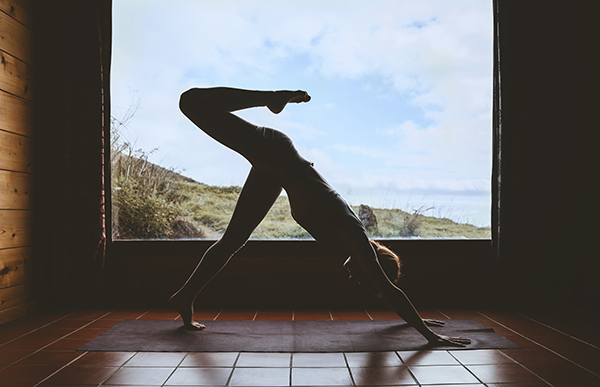When “lockdown” first became a popular verb amid the COVID-19 outbreak, I joined the millions of people around the world who were abruptly confined to our homes.
Regular exercise routines were quickly derailed, and many of us needed new outlets for stress relief and physical fitness.
I was fortunate enough to learn about online Pilates exercise classes right from the start of the pandemic – and I was immediately hooked. Pilates is a form of conditioning that relies on strengthening the body through stretching the muscles, and for a myriad of reasons – not least of all from years of sitting at a desk – my not-so-nimble body was in desperate need. While it took quite some time to learn stretches that my dog knew instinctively, I have practiced Pilates for more than two years now, twice a week.
All this exercise made me wonder: Is there more to the health benefits of stretching, and if so, why are humans generally not as diligent about extending our muscles every once in a while?
The Science of Stretching
Regular stretching allows the muscles to become, and remain, more flexible. This flexibility is key to maintaining the range of motion required to prevent tightness and shortening. In other words, after periods of inactivity, our range of motion can become more limited, and our muscles must work a lot harder to deliver the same power, resulting in greater muscle strain risk that can result in damage and pain. [1]
Humans are becoming more and more sedentary. According to the National Institutes of Health,[2] one in four U.S. adults spends about 70% of the day sitting. A revolution in information technology has resulted in many occupations not demanding the same levels of physical activity or mobility.
Sitting for long periods of time can make the body more inflexible. Inactivity can contribute to tight hamstrings that ultimately can impede even simple movements like walking. Inadequate desk setups and bad posture can further contribute to muscle tightening, resulting in burning shoulders, neck pain, and tension headaches. This becomes a negative spiral, where pain prompts people to adopt postures that fuel inflexibility and lead to yet more pain.

Simple stretching exercises to release muscle tension in the neck, shoulder, chest, and lower back muscles, on the other hand, can improve overall back alignment.[3] Furthermore, stretching activities can increase blood supply to the joints and muscles, improving the transportation of essential nutrients throughout our systems.
Stretching exercises offer a no-cost method to combat longer term movement challenges; these don’t require great time commitment, only consistency. Feland et al.[4] found that stretching for just 60 seconds at a time, five times per week for six weeks increases range of motion of 2.4 degrees per week in each muscle group. As stretching doesn’t tend to be part of regular daily routine, the researchers even defined a “long-duration” stretch as greater than 30 seconds for one repetition. That isn’t a long time at all to dedicate towards one’s health.
Mental Health Benefits of Stretching
The physical benefits of stretching everyday are apparent, but the mental health benefits might not be so obvious. Stretching can work to undo the tension in our muscles caused by everyday pressures. These can manifest in a variety of ways, such as tightening in the neck, shoulder, and back muscles. Furthermore, stretching can help us feel calmer and increase serotonin levels [5], the hormone responsible for improved mood. Serotonin is known to reduce stress, anxiety, and possibly the risk of depression and promote an overall sense of wellbeing. Plus, regular and consistent stretching promotes a healthy musculoskeletal system and improves blood circulation, which can result in a healthier spine and in less chronic pain.
Insurance Implications
Back disorders, accidental falling, mental illness, or joint and soft tissue disorders represent a growing proportion of total disability claims. Almost one in every five of RGA’s disability claims in 2021 was from one of these categories. If every policyholder were to stretch on a consistent basis and increase their flexibility, I wonder how many of these claims could be avoided?
Healthy, strong, and flexible muscles can also reduce the risk of falling in older policyholders by assisting with balance problems. Accidental falls are a high risk for policyholders at older ages, but these incidents can affect individuals at any age. Conversely, a stronger and more flexible body core could mitigate the risk of falling.
Mental illness claims span a spectrum of disorders and form a large part of any insurer’s claims book. For every fifteen disability claims that RGA saw in 2021, at least one was related to a mental illness. I am under no illusion that stretching alone could reduce the societal and insurance burden of these significant issues, but this simple practice can be an effective supplementary tool to assist claimants in returning to work. Daily long-hold stretches could form part of an effective treatment regimen in assisting claimants or policyholders in general.
Summary
The worst of the COVID-19 pandemic and lockdowns may be in the past, and I now have the luxury of running outdoors again. I am trying my best to stick to my Pilates classes and at least get in a good stretch every day. Knowing the benefits of stretching has changed my perspective on this fundamentally healthy practice, and I’m hoping to be rewarded for my efforts in the long term.




